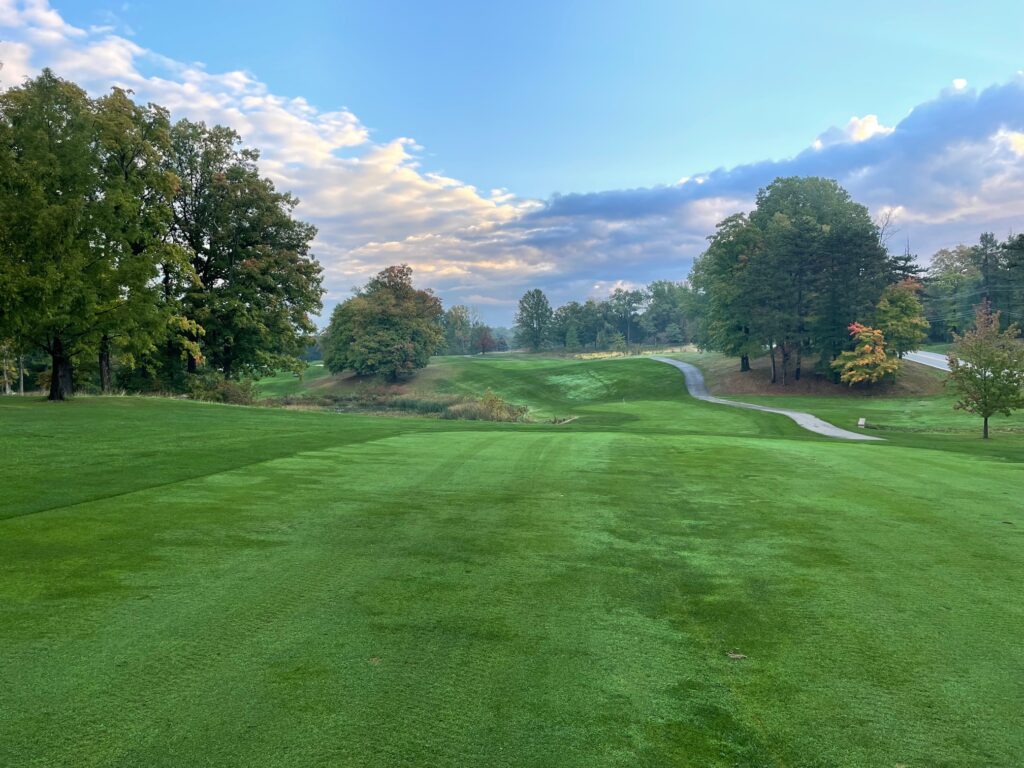If you have played golf for any period of time, you understand how important chipping can be to your overall score.
When you consider that the best golfers in the world only hit 14 out of 18 greens in regulation on average, leaving them at least 4 chip shots per round, you can start to appreciate the importance of chipping.
Or that the typical scratch golfer will hit around 12 greens out of 18 in regulation, leaving at least 6 chip shots.
This leaves your average amateur hitting somewhere between 6 and 18 chip shots per round.
For many golfers, the number of chip shots could rival the number of drivers you hit, which is typically around 14. Yet, many people will stand at the driving range and hit driver after driver in hopes of finding that perfect feeling to take to the course.
My favorite part about the short game is that anyone can be a quality chipper. It doesn’t take great strength, speed or athletic ability to be a phenomenal chipper. It only takes some simple technique, plenty of time and the willingness to practice.
Another great part about the short game is the ability to practice at home. Even if you have the smallest backyard in town, there are drills you can complete in your living room or basement.
Update: I practice chipping daily between my golf simulator setup in my garage and different drills that I will do in my basement between sets when working out. Keep in your chipping motion simple and work on quality contact and controlling distances!
How To Practice Chipping At Home
Golfers have two options: practice indoors or outdoors and utilize the drills that will help the golfer control contact, distance and direction. The gofler should consider buying wiffle balls and several practice nets to improve their overall performance the next time they head to the course.
Below, we will dive into two main topics:
- Drills that can be completed indoors at home.
- Drills that can be completed in the average backyard at home.
First, let’s dive into what makes a golfer a quality chipper.
The golfer, most importantly, must be able to control the quality of the contact. If the golfer is chunking or blading even 25% of his or her shots, the consistently just will not be there. The golfer should work tirelessly to ensure they remain calm through the shot and hit the ball crisp.
Second, the golfer must be able to control the distance. This can be controlled by club selection, swing speed and swing length. The best golfers are able to control these three variables to give themselves the best chance based on the undulations, speed of the greens, firmness of the greens and the overall distance the shot must carry.
Finally, the golfer must be able to aim and hit the target line. This might be the easiest of the three as the target is typically pretty close and aiming right at the pin or slightly left or right is rather simple for the majority of golfers.

Indoor Chipping Drills at Home
For all of these drills below, we are assuming you are using wiffle balls or ping pong bals. Both are great options as they provide a level of safety. Be careful taking even a chipping size swing inside your house.
Option #1: Basic Chip
Take your lob wedge and a wiffle ball/ping pong ball and aim at a bucket. See how many shots out of 10 you are able to chip in the bucket. Hit at least 100 chip shots to learn the most basic chip with the lob wedge. With today’s firm and fast green found on the majority of golf courses, the golfer must be able to utilize a 60 degree wedge or lob wedge to get the ball up in the air and utilize some loft to help the ball stop.
Helpful Post: Chipping from tight lies
Option #2: The Hit, Skip and Stop Shot
Keep your lob wedge and your wiffle ball/ping pong ball and put the ball back in your stance with your hands forward. Learn to hit a basic chip shot that will fly lower, hit a couple of time and spin to a stop. This shot is often best with a 60 degree wedge as your are able to hit down and through the ball and create enough spin to help it stop. This shot is a great option when you have around 20-30 yards left with plenty of green and you are in the fairway. It allows you to stay aggressive and use spin to create a larger margin or error
Option #3: Bump and Run
Depending on your amount of space, you can use an actual golf ball as long as your keep your swing really simple like a putting motion. Go ahead and use your putting motion and work on a 7 or 8 iron bump and run. If you have decent carpet, the overall distance should be just somewhat slower than a green that you might play. Go ahead and work on your direction and distance control. Hit at least 100 of these per day and you will find yourself getitng really comfortable with your golf swing.
Option #4: Bump and Run/Make the Putt
If you have a large basement with carpet, you can practice the bump and run and then make the putt. Play 18 holes and see how many times you can hit a quality chip shot and make the putt. This is great practice and can create some pressure to see if you can handle the pressure. Working on the putting during your short game practice is never a bad idea.
Helpful Post: Top 5 tips for chipping!

Outdoor Chipping Drills at Home
You can repeat at least the first two drills above, but complete them outside with an acutal golf ball depending on the amount of space that you have. Here are some additional drills.
Option #1: One Handed Chipping Drill
Work on one handed chipping drills with both hands. It will keep you from getting flippy at the bottom and learn to maintain a stable force through the shot. This drill will help you control the club face and keep your arms moving through the shot.
Helpful Post: What degree wedge is best for chipping
Option #2: Juggling
Take your 60 degree wedge and see how many times you can juggle the golf ball ont he face of your golf club. While this does not guarantee you will be a great chipper, it does build some touch and the ability to control the face. While juggle won’t make you a great golfer, I don’t know many really good golfers that can’t juggle.
Option #3: Longer Shots
You can take and expand your chipping practices with some really long chip shots utilizing the wiffle or soft/mush golf balls on the market. You can practice those 30-60 yard pitch shots and learn to control the club face and your distance, testing out different ball positions and swing feels.
Option #4: Flop Shots
With those same wiffle balls or soft/mush balls you can open the face up and practice those lob/flop shots that Phil Mickelson is known to play. While you may not use this shot often, it is a quality shot to have in your bag. Using the wiffle ball or soft/mush ball you can experiment with different feels and how open you want to open the clubface without fear of blading one across the practice green.

Final Thoughts: The Importance of the Short Game in Golf
The short game is essential. Check out our chart below on what the typical scratch golfer is able to do. Check out our 4th bullet point below.
THE STATS – The Recipe
| Greens in Regulation | 67% |
| Fairways Hit | 53% |
| Putts Per Hole | 1.67 |
| Scrambling | 54% |
| Sand Saves | 59% |
| Average Driving Distance | 251 |
Some Major Takeaways From The Table Above:
- 12 out of 18 greens in regulation seems doable on an average course. This is 2 out of every 3 holes, we must be able to hit the green in regulation.
- The 53% for fairways hit can always be a bit misleading. Are the other 47% of drives still in play and the only barrier is a bit of rough? Or is the ball now behind the tree. A stat I would like to see is if you have a clean, unobstructed shot to the green. I believe this is the game changer in scoring
- The putts per hole seems somewhat achievable. Where this number can be thrown off is if the one putts are to save par or to make birdies after a green hit in regulation.
- The scrambling stat is not surprising at all. I would have thought that one must be above 50% to become a scratch golfer. I have heard that PGA Tour players expect to chip a ball within a 3 foot circle – 7 out of 10 times. If a scratch golfer can do this 5 out of 10 times and then make one putt outside of 3 feet, they can easily average around 60% in scrambling.
- The sand saves is an impressive number as it is actually higher than the scrambling percentage. This shows that scratch golfers save par more from the sand then the rough.
- The average driving distance is actually lower than I would have anticipated. A 250 driving average only takes around a 103 mile per hour swing speed.
Take Action – What You Can Do Today to Get Better
What does this mean for you? I believe in the following recipe to get better:
1 – Improve your motion in the golf swing by identifying a golf instructor. Here are some options:
Here is a list of golf instructors that we have reviewed:
2 – Train to swing faster and improve your swing speed. Here are some options:
Looking to gain more Speed and Distance in your swing. Two Options:
3 – Understand course strategy and work to break through your next barrier. Here is a series on breaking through:
We have provided guides on how to break 100, 90, 80 and 70. Check out more below, if interested.
4 – Practice Frequently
Did you know that I build a golf simulator in my garage and have played over 500 rounds of golf on my SkyTrak system? It has been a game changer and one worth checking out. Here are some of my other posts on golf simulators frequently asked questions:
- Is a Golf Simulator Worth It?
- How to Build a Golf Simulator?
- What is the Best Golf Simulator?
- Golf Simulator Accessories?
- How to Build a Golf Simulator for under $7000
- Top 11 Reasons to Buy a SkyTrak
- How to Build a Golf Simulator for Under $1000
- Why Build A Golf Simulator?
- What Space is Needed?
- Can A Golf Simulator Improve My Game?
- How Much Does A Golf Simulator Cost?
- Don’t Forget to Check out our 15 best golf swings of all time.
I am an amateur golfer on a journey to get better, enjoy the game as often as possible and share my passion and knowledge with others. I have coached high school golfers at a high level and have a great passion for the game and want to give back. I enjoy learning about the golf swing and am currently studying to be a certified professional golf instructor. Join me in our journey to get better everyday. Thank you for reading!

